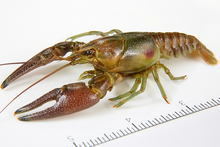Quick facts
Rusty crayfish is a regulated invasive species. Regulated Invasive Species (MN DNR) are legal to buy, sell, transport, and possess, but may not be introduced into a free-living state, such as released into public waters.
- Rusty crayfish feeding habits threaten native plant beds and native fish eggs and young fish.
- They can drive native crayfish out, making them susceptible to predators.
Rusty crayfish should be reported. Learn how to report invasive species in Minnesota.
How to identify rusty crayfish
- Rusty crayfish (Orconectes rusticus (syn. Faxonius rusticus)) has a light to dark brown body. Rusty, red-colored spots are present on either side of carapace.
- Spot size and darkness is highly variable across individuals.
- Has larger, more robust claws than native crayfish species.
- Claws have dark black bands on the tips.
- When closed, the claws have an oval gap in the middle.
Life cycle
- Mature rusty crayfish mate in late summer, early fall, or early spring.
- Rusty crayfish females can lay between 80 and 575 eggs.
- Females carry sperm transferred from male crayfish until eggs are ready for fertilization. It is possible for a single crayfish to start a new population if transferred to a new water body.
- Eggs hatch in three to six weeks depending on water temperature.
- Juveniles stay with the female for several weeks after hatching and reach full maturity the following year upon completion of about 8 to 10 molt cycles.
- Rusty crayfish typically live 3–4 years.
Reviewed in 2019



